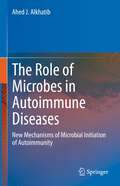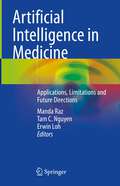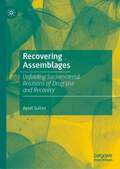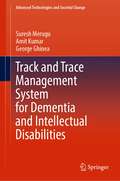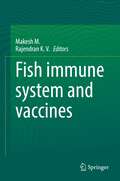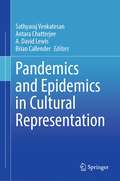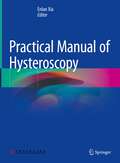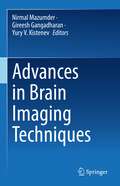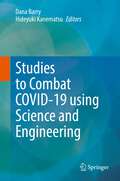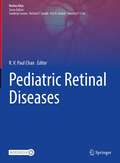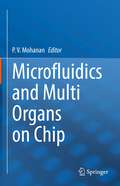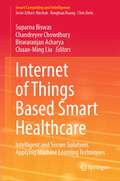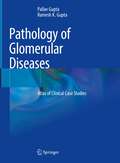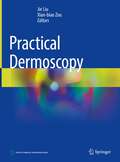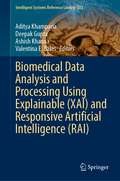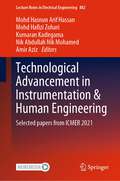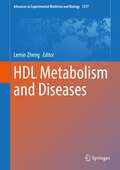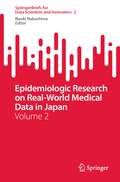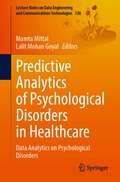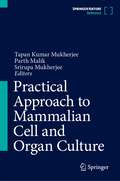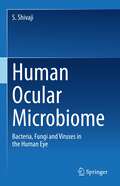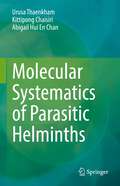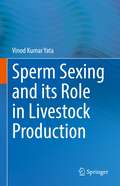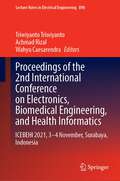- Table View
- List View
The Role of Microbes in Autoimmune Diseases: New Mechanisms of Microbial Initiation of Autoimmunity
by Ahed J. AlkhatibThis book provides a comprehensive, up-to-date review of the state of knowledge on the role of microbes in inducing autoimmune diseases. The initial chapters address the basic concept and clinical implications of immunology, while the following section discusses the role of genetics, epigenetics, hormones, stochastic and environmental factors in the pathogenesis of autoimmunity. The third section introduces readers to various autoimmune disorders and presents the cellular and molecular mechanisms of autoimmune diseases. In closing, the book examines the role of intestinal flora in the development of autoimmune diseases, delineates the underlying mechanism responsible for autoimmunity onset, and examines the potential of microbial therapeutics in the prevention and treatment of autoimmune diseases. Given its scope, the book offers a valuable asset for all scientists and clinicians working in immunology, rheumatology and autoimmune diseases.
Artificial Intelligence in Medicine: Applications, Limitations and Future Directions
by Manda Raz Tam C. Nguyen Erwin LohThis book identifies Artificial Intelligence (AI) as a growing field that is being incorporated into many aspects of human life, including healthcare practice and delivery. The precision, automation, and potential of AI brings multiple benefits to the way disease is diagnosed, investigated and treated. Currently, there is a lack of any appreciable understanding of AI and this book provides detailed understandings, which include; foundational concepts, current applications, future challenges amongst most healthcare practitioners. The book is divided into four sections: basic concepts, current applications, limitations and future directions. Each section is comprised of chapters written by expert academics, researchers and practitioners at the intersection between AI and medicine. The purpose of the book is to promote AI literacy as an important component of modern medical practice. This book is suited for all readers as it requires no previous knowledge, it walks non-technical clinicians through the complex ideas and concepts in an easy to understand manner.
Recovering Assemblages: Unfolding Sociomaterial Relations of Drug Use and Recovery
by Aysel SultanRecovering Assemblages offers an exciting new insight into the policies and practices of recovery and drug use bridging critical drug studies and the sociology of health and illness. The book investigates lived experiences of young people in Azerbaijan and Germany during their personal recovery from alcohol and other drug use and shows the contingency of 'real' experiences. The sociomaterial and ontological analyses unfold the interrelation of practices, spaces, bodies, and affects in experiencing recovery both within and outside of various treatment facilities. The book will appeal to a range of scholars, postgraduates, and undergraduates engaged in critical, methodological, and empirical studies of recovery, drug use, and policy.
Track and Trace Management System for Dementia and Intellectual Disabilities (Advanced Technologies and Societal Change)
by Suresh Merugu Amit Kumar George GhineaThis book reviews humanitarian literature and presents the development of low-cost track & trace management system integrated with accurate GPS location data pinging using Internet of Things (IoT). The first part relates to mobile device configuration with an embedded GPS and wireless Internet connection to transmit its current location. The second part presents web server implementation and development that receives the data, parses it, and stores it for access over the Internet. The third part discusses the user interface that allows one to visually identify the current location of the device.
Fish immune system and vaccines
by M. Makesh K. V. RajendranThis book is a collection of comprehensive and latest information on all aspects of vaccination in fish and shellfish. It provides the basic understanding about the immune system of both fish and crustaceans, besides giving the latest information on adjuvants, vaccine delivery methods, adverse effects of vaccines and methods to assess the efficacy of vaccines. Separate chapters on the role of pattern recognition receptors and interferons in fish vaccination, biofilm vaccines and biosafety and regulatory requirements for fish vaccines are also included. Aquaculture, being the fastest growing food producing industry in the world, is looked upon for alleviating the malnutrition especially among the under privileged population. However, intensive aquaculture practices have led to increased incidences of diseases and significant production losses. Among various health management measures employed in aquaculture, vaccination has been proven to be the best approach to protect fish against pathogens. It is considered to be safe and is a key factor for sustainable aquaculture. In this background, apart from the basic understanding of fish and shellfish immune system, updated knowledge on various types of vaccines and the vaccination strategies currently employed in aquaculture are also covered. The book is designed to provide the latest and comprehensive knowledge on all these aspects as a compiled resource material which is useful to students, researchers and other professionals in the field of aquaculture.
Pandemics and Epidemics in Cultural Representation
by Sathyaraj Venkatesan Antara Chatterjee A. David Lewis Brian CallenderThis edited book analyses how artists, authors, and cultural practitioners have responded to and represented episodes of epidemics/pandemics through history. Covering a broad range of notable epidemics/pandemics (black death, cholera, Influenza, AIDS, Ebola, COVID-19), the chapters examine the cultural representations of epidemics and pandemics in different contexts, periods, languages, media, and genres. Interdisciplinary in nature and drawing on perspectives from medicine, literature, medical anthropology, philosophy of medicine, and cultural theory, the book investigates and emphasizes the urgent need to reflect on past catastrophes caused by such outbreaks. By delving into cultural history, it re-examines how societies and communities have responded in the past to species-threatening epidemics/pandemics. Sure to be of interest to lay readers as well as students and researchers, this work situates epidemics and pandemics outbreaks within the contexts of culture and narrative, and their complex and layered representation, commenting on intersections of contagion, culture, and community. It offers a cross-cultural, global, and comparative analysis of the trajectories, histories and responses to various epidemics/pandemics that impacted people worldwide.
Practical Manual of Hysteroscopy
by Enlan XiaThis book aims to provide readers with the latest information on application of hysteroscopy in diagnosis and treatment of gynaecological diseases. The first chapters systematically review current status, equipment and instruments, applied anatomy, preoperative treatment and anesthesia for hysteroscopic surgery. In the following chapters, details in aspect of hysteroscopy from diagnostic to hysteroscopic surgery are explained with clinical cases. After that, advanced techniques in hysteroscopy combined with laparoscopy and ultrasound monitoring hysteroscopic surgery are introduced with high-resolution illustrations. Written by experts with wealthy experience in the field, this book will be a valuable reference for gynecologists at hysteroscopy units, reproductive units, gynecological and oncological units.
Advances in Brain Imaging Techniques
by Nirmal Mazumder Gireesh Gangadharan Yury V. KistenevThe book reviews the recent developments in brain imaging and their technological advancements to understand molecular mechanisms associated with neurological disorders and basic behaviors in humans and rodents at the structural, molecular, and functional levels. It discusses the usefulness of advanced optical microscopy techniques, including optical coherence tomography (OCT), miniscope, multiphoton fluorescence (2PF & 3PF), adaptive optics, harmonic generation, and Raman microscopy for understanding pathomechanism of brain disorders and pathological and physiological changes associated with neurodegenerative diseases. Also, the book presents conventional imaging modalities, including Magnetic Resonance Imaging (MRI), for delineating underlying mechanisms and precise early diagnosis of neurological disorders. This book is a useful resource for neuroscientists and researchers working in biomedical engineering and optics.
Studies to Combat COVID-19 using Science and Engineering
by Dana Barry Hideyuki KanematsuThis unique book provides excellent examples of ongoing, leading-edge research related to viruses, especially COVID-19. It is written from the viewpoint of various scientific fields including materials science. It introduces and describes viruses (submicroscopic infectious agents that replicate inside the living cells of an organism), various infections caused by viruses (human to human, human to other organisms to humans, humans to materials to humans, etc.), not only from the viewpoint of medical research but also from other scientific disciplines. A major focus of the book is the COVID-19 virus. Highlighted topics include the evolution of COVID-19, transmission of virus particles through the air, virus spread through various materials, detection of the virus by testing wastewater, the development and testing of vaccines and therapeutic drugs, and the preparation for future viruses and pandemics. This includes reform in funeral services to properly and safely accommodate very large numbers of bodies in a pandemic, like those seen in New York City when it was the epicenter for the virus in the United States. This book serves as an excellent and very informative guide (practical book) for engineers and researchers of various backgrounds and as a great academic textbook.
Pediatric Retinal Diseases (Retina Atlas)
by R. V. Paul ChanThis volume on pediatric retina covers all aspects of pediatric retinal diseases as their understanding, diagnosis and management is still under evolution and a challenging task. Newer diagnostic and surgical techniques are being developed and are being adapted for better visual outcome in pediatric cases. It comprises of 10 chapters describing the medical and surgical aspects. The text and figures have been provided in a lucid manner to enhance the understanding of the reader. This volume covers OCT angiography for pediatric retinal disease, clinical spectrum of retinopathy of prematurity, which has become an ever increasing burden of disease for the society and needs special attention, anti-VEGF for retinopathy of prematurity, surgical management of retinopathy of prematurity, retinopathy of prematurity: atypical aspects, Coats’ disease, pediatric retinal inflammatory disorders, congenital X-linked retinoschisis, familial exudative vitreoretinopathy, hematologic disorders: leukemia, hyperviscosity, anemia. It provides descriptions of these disease accompanied by numerous helpful images to highlight these conditions. This atlas will assist the vitreoretinal specialists, general ophthalmologists, retina fellows and post graduate students in successfully identifying the key features of these challenging pediatric vitreoretinopathies. Pediatric Retinal Diseases is one of the nine volumes of the series Retina Atlas. This series provides global perspective on vitreoretinal diseases, covering imaging basics, retinal vascular disease, ocular inflammatory disease, retinal degeneration, surgical retina, ocular oncology, pediatric retina and trauma. Retina Atlas is spread over 9 volumes and about 100 chapters, covering validated and comprehensive information on retinal disorders.
Microfluidics and Multi Organs on Chip
by P. V. MohananThis book highlights the application of microfluidics in cell biology research, chemical biology, and drug discovery. It covers the recent breakthroughs and prospects of organ-on-a-chip, human-on-a-chip, multi-organ-on-a-chip for personalized medicine. The book presents the preclinical studies of organs-on-a-chip, concepts of multiple vascularized organ-on-chips, application of organ-on-a-chip in blood-brain barrier model, culture and co-culture of cells on multi-organ-on-chip and parameter measurements in microfluidic devices. It underscores the advantage of microfluidic devices for developing efficient drug carrier particles, cell-free protein synthesis systems, and rapid techniques for direct drug screening. Further, it entails human-on-a-chip for measuring the systemic response as well as immediate effects of an organ reaction on other organs. In summary, this book reviews the development of a microfluidic-based organ-on-a-chip device for the preclinical evaluation, ADME studies of drugs, chemicals, and medical devices. This book is a valuable source for pharma companies, product developers, students, researchers, academicians, and practitioners.
Toilet as Business for the Hygiene of the Chinese Community in Colonial Hong Kong
by Yuk-sik ChongThis book analyses how public toilets were provided by the government and local business in Hong Kong between the 1860s and 1930s through a process that was embedded in class and racial politics. Addressing public toilet provision from a political economy perspective, it focuses on the interplay of the cross-border night soil business between Hong Kong and China’s silk producing area; the silk market between China and Colonial powers; the Hong Kong land market between the colonial government and Chinese business; and how these factors jointly produced a network of toilets in the colony. As the book shows, the commercial viability of toilets created multiple logics and a new moral geography; further, exploring the topic can help us gain a better understanding of how urban governance functioned in colonies and how it intertwined with economic contingencies within a global economic system. The intended readership includes academics and members of the general public with an interest in colonialism, public infrastructures, public health, government–business relations, and urban governance.
Internet of Things Based Smart Healthcare: Intelligent and Secure Solutions Applying Machine Learning Techniques (Smart Computing and Intelligence)
by Suparna Biswas Chandreyee Chowdhury Biswaranjan Acharya Chuan-Ming LiuThis book provides both the developers and the users with an awareness of the challenges and opportunities of advancements in healthcare paradigm with the application and availability of advanced hardware, software, tools, technique or algorithm development stemming the Internet of Things. The book helps readers to bridge the gap in their three understanding of three major domains and their interconnections: Hardware tested and software APP development for data collection, intelligent protocols for analysis and knowledge extraction. Medical expertise to interpret extracted knowledge towards disease prediction or diagnosis and support. Security experts to ensure data correctness for precise advice. The book provides state-of-the-art overviews by active researchers, technically elaborating healthcare architectures/frameworks, protocols, algorithms, methodologies followed by experimental results and evaluation. Future direction and scope will be precisely documented for interested readers.
Pathology of Glomerular Diseases: Atlas of Clinical Case Studies
by Pallav Gupta Ramesh K. GuptaThis book provides clear understanding of morphological appearances of various glomerular lesions encountered in a wide range of diseases involving renal glomeruli. Chapters cover various diseases with each chapter including a brief text and multiple colored microphotographs depicting the distinctive morphological features of glomeruli as may be encountered in these diseases. It presents complete clinical history with thorough lab workup and other related investigations as considered essential for proper evaluation of the patient. The book provides systemic approach for proper diagnosis of the underlying disease condition in view of the clinical workup and renal biopsy assessment. It provides visual understanding of the glomerular pathology that helps the consultant nephrologist to have a clear understanding of underlying renal disease thus helping in proper evaluation and appropriate therapeutic management of the patient. It may also guide to predict the likely prognostic outcome of the patient. This book is not only helpful to renal pathologists and nephrologists but also serves as a valuable resource for clear understanding of the glomerular lesions to the beginners and postgraduates in nephrology and renal pathology and other physicians managing the patients of renal diseases
Practical Dermoscopy
by Jie Liu Xian-biao ZouThis book aims to provide readers with practical information on the procedure of streamline skin disease recognition with the use of dermoscopy. The first three chapters are mainly focused on the basic knowledge of dermoscopy, such as its history, how it works, the terminology. In the following chapters, the clinical photographs, dermoscopic images and histopathologic images of benign melanocytic neoplasms, malignant melanoma, basal cell carcinoma, seborrheic keratosis and related diseases, vascular diseases, squamous cell neoplasms and other neoplasms are presented in a case-based format. The clinical characteristics are introduced briefly, and the dermoscopic features are highlighted with a number of pictures. The chapter 12 to chapter 14 introduce the dermoscopic appearance of inflammatory skin diseases, infectious and parasitic skin diseases, hair and nail diseases, respectively, which is the extended application of dermoscopy. Last but not least, the development and future of articifial intellegence assisted diagnosis based on dermoscopic images is introduced. Written by dermatologists who have been involved in dermoscopic diagnosis for a long time, this case-based book will be a valuable reference for dermatologists and those who are interested in related field.
Biomedical Data Analysis and Processing Using Explainable (Intelligent Systems Reference Library #222)
by Aditya Khamparia Deepak Gupta Ashish Khanna Valentina E. BalasThe book discusses Explainable (XAI) and Responsive Artificial Intelligence (RAI) for biomedical and healthcare applications. It will discuss the advantages in dealing with big and complex data by using explainable AI concepts in the field of biomedical sciences. The book explains both positive as well as negative findings obtained by explainable AI techniques. It features real time experiences by physicians and medical staff for applied deep learning based solutions. The book will be extremely useful for researchers and practitioners in advancing their studies.
Technological Advancement in Instrumentation & Human Engineering: Selected papers from ICMER 2021 (Lecture Notes in Electrical Engineering #882)
by Mohd Hasnun Arif Hassan Mohd Hafizi Zohari Kumaran Kadirgama Nik Abdullah Nik Mohamed Amir AzizThis book (Technological Advancement in Instrumentation & Human Engineering) gathers selected papers submitted to the 6th International Conference on Mechanical Engineering Research in fields related to human engineering, ergonomics, vibration, instrumentation, Internet of Things and signal processing. This proceeding consists of papers in aforementioned related fields presented by researchers and scientists from universities, research institutes and industry showcasing their latest findings and discussions with an emphasis on innovations and developments in embracing the new norm, resulting from the COVID pandemic.
HDL Metabolism and Diseases (Advances in Experimental Medicine and Biology #1377)
by Lemin ZhengThis book focuses on both high-density lipoproteins (HDL) metabolism and related diseases from the perspectives of the world-class experts in HDL. Several chapters in this book provide the overall information about HDL metabolism via detailed discussion of HDL structures as well as several key molecules involved in its functions, such as SR-B1 and Cholesteryl Ester Transfer Protein Inhibitors and so on. The rest of this book illustrates the connection between HDL and several diseases that are the major concerns of people’s health in many countries, and devotes to exploring the therapies of HDL related diseases. With a better understanding of the HDL metabolism and diseases, this book will benefit the audiences with interest in HDL from biomedicine to clinical practice.
Epidemiologic Research on Real-World Medical Data in Japan: Volume 2 (SpringerBriefs for Data Scientists and Innovators #2)
by Naoki NakashimaThis book analyzes the development of medical big data projects in Japan.Japan is experiencing unprecedented population aging, and labor productivity has decreased accordingly. Big data analysis of the Japanese medical real-world database (RWD) has the potential to tackle this issue.To allow readers to gain an understanding of Japanese medical big data analysis, the book discusses the original Japanese system that generates medical RWDs in the hospital medical records system, the nationwide standardized health checkup system, and the public medical insurance system in Japan.After introducing four major big data projects in the healthcare–medical field in Japan, the book explains the importance of creating information standards to maintain data quality and to analyze medical big data. It enables readers to analyze which standards are installed in which RWDs, how the standards are maintained, and which issues are prevalent in Japan.This book also describes the ethical processes involved in big data projects involving medical RWDs in Japan.
Predictive Analytics of Psychological Disorders in Healthcare: Data Analytics on Psychological Disorders (Lecture Notes on Data Engineering and Communications Technologies #128)
by Mamta Mittal Lalit Mohan GoyalThis book discusses an interdisciplinary field which combines two major domains: healthcare and data analytics. It presents research studies by experts helping to fight discontent, distress, anxiety and unrealized potential by using mathematical models, machine learning, artificial intelligence, etc. and take preventive measures beforehand. Psychological disorders and biological abnormalities are significantly related with the applications of cognitive illnesses which has increased significantly in contemporary years and needs rapid investigation. The research content of this book is helpful for psychological undergraduates, health workers and their trainees, therapists, medical psychologists, and nurses.
Practical Approach to Mammalian Cell and Organ Culture
by Tapan Kumar Mukherjee Parth Malik Srirupa MukherjeeThis Major Reference Work offers a detailed overview of culturing primary, secondary cell lines, tissues, and organs.It first introduces various types of mammalian cell cultures, infrastructure requirements for a mammalian cell-culture laboratory. The subsequent chapters present the detailed protocols for the isolation of mammalian hematologic organs and cells. It also discusses various cell-based assays for monitoring cell viability, cell proliferation, cytotoxicity, cell senescence, and cell death assays.In addition, the book addresses the various problems encountered while culturing animal cells, their possible causes, and suggested solutions, presenting detailed protocols for isolation and primary culturing of various mammalian cells and hematoimmunologic organs in two dimensions.Lastly, it reviews the various applications of animal-cell culture, stem-cell culture, and tissue and organ culture. As such, this reference book is highly relevant for students and professionals new to cell-culture work as well as to those wishing to expand their skills from cell-line cultures to primary cultures and from conventional 2D cultures to 3D cultures.
Human Ocular Microbiome: Bacteria, Fungi and Viruses in the Human Eye
by S. ShivajiThis book provides an integrated review of the human ocular microbiome. It documents the discovery of ocular surface microbes by the conventional cultivable method and next generation sequencing technologies in both healthy and diseased (keratitis, uveitis, endophthalmitis, blepharitis, conjunctivitis etc.) eyes. The book further discusses the confounding factors that influence the microbiome, mycobiome and virome. The chapters cover niche-specificity with reference to skin, eyelid- margin, hands etc. It highlights the concept of core genera, dysbiosis and discriminating genera and covers the functional relevance of the dysbiotic microbiome, mycobiome and virome with respect to ocular diseases. The book includes topics on the relevance of molecular mechanisms, including quorum-sensing and mucin metabolism to ocular disorders, such as dry eye; and, microbiome-based therapies for treating of ocular disorders like vernal keratoconjunctivitis. The book is essential for microbiologists studying the human eye, ophthalmologists treating eye infection and trauma. It also caters to students of medical microbiology and medicine.
Molecular Systematics of Parasitic Helminths
by Urusa Thaenkham Kittipong Chaisiri Abigail Hui En ChanThis book aims to provide fundamental knowledge and information for research in molecular systematics on parasitic helminths (nematode, trematode, cestode). The shreds of evidence of molecular systematics studies will be compiled and discussed in terms of the utilities and pitfalls of the genetic marker used for various purposes, which have been implemented for molecular systematics of parasitic nematodes, cestodes, and trematodes. Moreover, this book will also provide the procedure for research on molecular systematics and DNA taxonomy as the guideline to explore parasitic helminths. Finally, the further perspectives of utilizing genetic markers for molecular studies on parasitic helminths will be addressed in the context of applications from the laboratory to fieldwork such as DNA barcoding and environmental DNA metabarcoding of parasitic helminths. The book will benefit postgraduate students and researchers requiring the detailed knowledge of molecular systematics, as well as researchers desiring a guideline to select genetic markers and analyze DNA sequences to make phylogenetic inferences
Sperm Sexing and its Role in Livestock Production
by Vinod Kumar YataThis book presents basic principles and discusses the state-of-the-art methods of sperm sexing in livestock. It reviews the challenges and critical opinions on the conventional sperm sexing methods and characteristic features of spermatozoa of farm animals which could help to develop novel methods of sperm sexing. The book also presents principles and applications of flow cytometry for sperm separation. The chapters of the book elucidate methods and difficulties in developing sperm sexing methods. Notably, it covers recent research on immunological and nanotechnology-based sperm sexing methods. The book also provides information on the development of semen extenders. Towards the end, the book examines ethical and commercial aspects of sperm sexing. It is an ideal reference book for students, researchers and professionals working towards improving livestock production.
Proceedings of the 2nd International Conference on Electronics, Biomedical Engineering, and Health Informatics: ICEBEHI 2021, 3–4 November, Surabaya, Indonesia (Lecture Notes in Electrical Engineering #898)
by Triwiyanto Triwiyanto Achmad Rizal Wahyu CaesarendraThis book presents high-quality peer-reviewed papers from the International Conference on Electronics, Biomedical Engineering, and Health Informatics (ICEBEHI) 2021 held at Surabaya, Indonesia, virtually. The contents are broadly divided into three parts: (i) electronics, (ii) biomedical engineering, and (iii) health informatics. The major focus is on emerging technologies and their applications in the domain of biomedical engineering. It includes papers based on original theoretical, practical, and experimental simulations, development, applications, measurements, and testing. Featuring the latest advances in the field of biomedical engineering applications, this book serves as a definitive reference resource for researchers, professors, and practitioners interested in exploring advanced techniques in the field of electronics, biomedical engineering, and health informatics. The applications and solutions discussed here provide excellent reference material for future product development.
